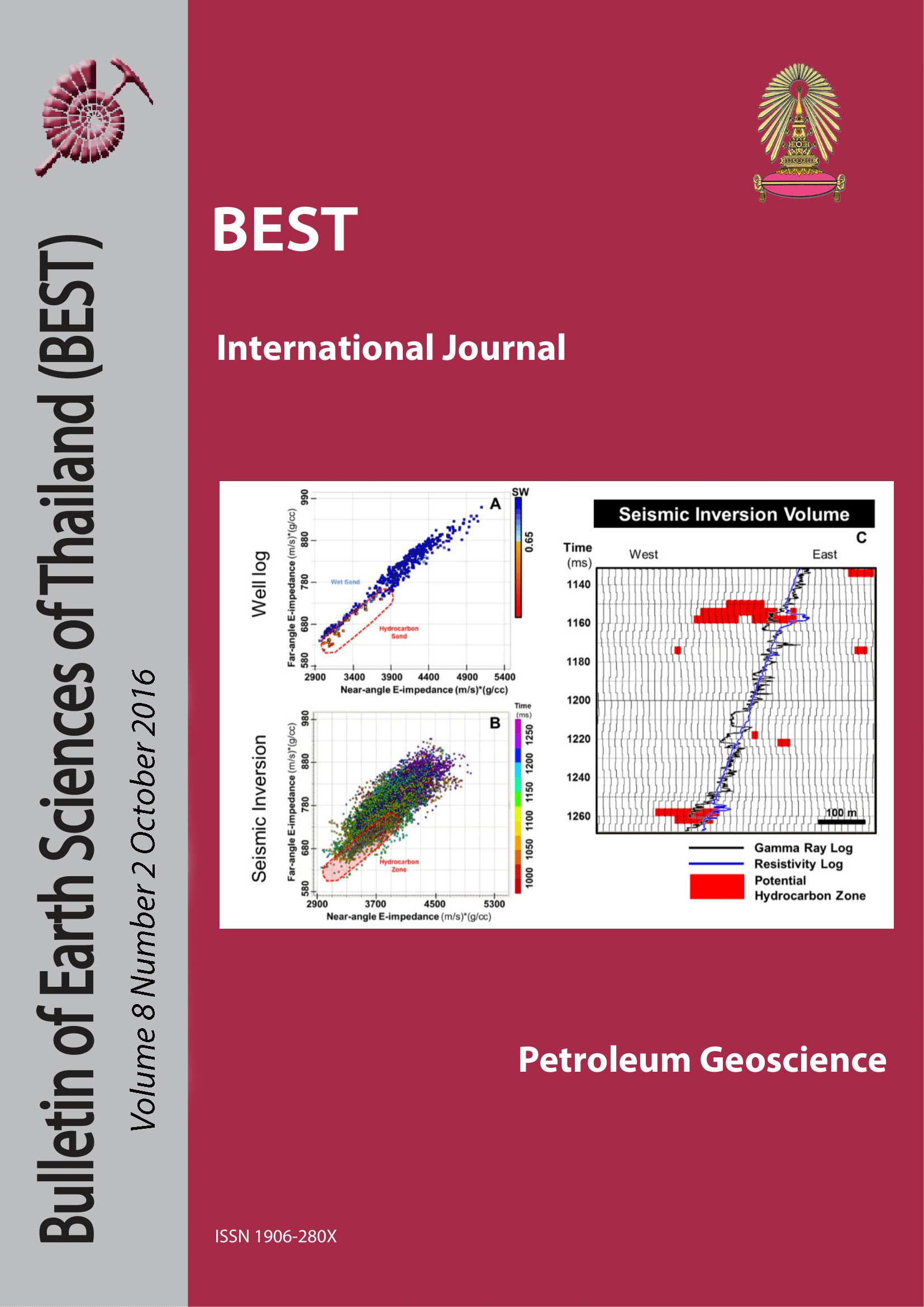ROCK PHYSICS AND SEISMIC INVERSION ANALYSIS FOR RESERVOIR IDENTIFICATION IN SW PALAWAN PHILIPPINES
Main Article Content
Abstract
Rock physics analysis and seismic inversion in Service Contract 63, Southwest Palawan Basin, Philippines, has been found to be an effective way to delineate the clastic and carbonate reservoirs within the block. Two types of inversion were conducted, namely, a simultaneous inversion using partial seismic angle stack data for the Pagasa Formation and an acoustic impedance inversion using full stack seismic data for the Nido Limestone. It is difficult to distinguish the sands and shales in the Pagasa Formation but the gas sands could be differentiated from brine sands and shales in the acoustic impedance (AI)-extended elastic impedance (EEI) domain, where two types of gas sands were delineated. The first type corresponds to low AI and high EEI, whereas the second type relates to moderate AI and low EEI and correlates to the interval that flowed 50 MMscfgpd of gas in the Abo Abo-A1X well. The higher AI in the second type of gas sand could be brought about by the presence of limestone fragments in the sands as defined from petrographic analysis. The limestones on the other hand have high AI and correlate to the bright reflectors on seismic data. For the Nido Limestone, low AI values can be correlated to high porosity while higher AI values are associated with lower porosity This predictable relationship between acoustic impedance and carbonate porosities is similar to the reported character of the Nido Limestone in the Northwest Palawan Basin. Seismic inversion is a viable tool that can be used to identify the presence of both clastic and carbonate reservoirs and reduce the exploration risk in the Southwest Palawan Basin
Article Details

This work is licensed under a Creative Commons Attribution-NonCommercial-NoDerivatives 4.0 International License.
Copyright © 2008 Department of Geology, Faculty of Science, Chulalongkorn University. Parts of an article can be photocopied or reproduced without prior written permission from the author(s), but due acknowledgments should be stated or cited accordingly.
References
Borbajo, R.M., 2010, Reservoir Characterization of the Nido Limestone in the Northwest Palawan Basin using Seismic Inversion: A research Report submitted as partial fulfillment for the Degree of Master of Science in Petroleum Geoscience at Chulalongkorn University, Thailand.
Connolly, P., 1999, Elastic impedance: The Leading Edge, 18, No.4, 438–452.
Fatti, J. L., Smith, G. C.,1994. Detection of gas in sandstone reservoir using AVO analysis: A 3-D seismic case history using Geostack technique: Geophysics, Vol.59, No.9; 1362-1376
Forbes, M.T., Mapaye, C.B., Bacud, J.A., 2011. Structural characterization of offshore Southwest Palawan, Philippines using the most recent 2D/3D seismic data. In Proceedings of the Southeast Asia Petroleum Exploration (SEAPEX) Meeting, Manila, Philippines, 6 April 2011.
Fournier, F., and J. Borgomano, 2007, Geological significance of seismic reflections and imaging of the reservoir architecture in the Malampaya gas field (Philippines): AAPG Bulletin, 91, 235–258.
Shuey, R.T., 1985, A simplification of the Zoeppritz equations: Geophysics, 50, 609-614.
Smith, G.C., and Gidlow, P.M., 1987, Weighted stacking for rock property estimation and detection of gas: Geophys. Prosp.,35, 993-1014.
Steuer, S., Franke, D., Meresse, F., Savva, D., Pubellier, M., Auxietre, J.-L. and Aurelio, M., 2013. Time constraints on the evolution of the southern Palawan Island, Philippines from onshore and offshore correlation of Miocene limestones. Journal of Asian Earth Sciences.
Whitcombe, D.N., Connolly, P.A., Reagan, R.L. and Redshaw, T.L., 2000, Extended elastic impedance for fluid and lithology prediction: 70th Ann. Internat. Mtg., Soc.Expl. Geophys., Expanded Abstracts.
Whitcombe, D. N., 2002, Elastic impedance normalization: Geophysics, 67, 60-62.


